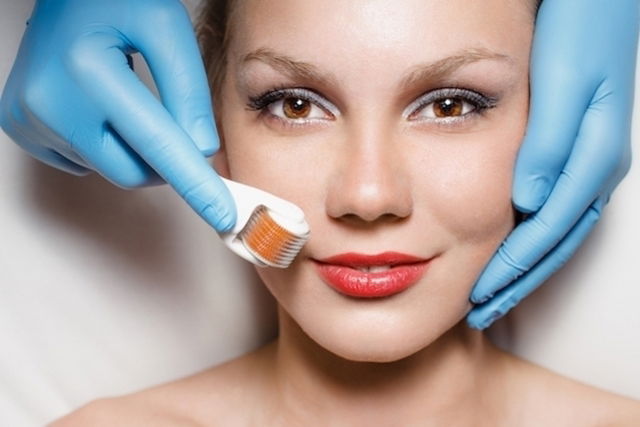Popping and squeezing pimples can lead to spots and scars on the skin. Acne commonly affects the forehead, cheeks, side of the face and chin, and can greatly affect a person’s self-esteem and confidence.
Acne scars often do not go away on their own, and may require additional dermatologic interventions to help improve their appearance. Some treatments include applying chemical peels, microneedling, microdermabrasion and laser.
Treatment should be based on the patient’s age, skin type, scar depth, time availability and financial status.

Commonly used acne treatments include:
1. Facial creams and medications
The dermatologist may prescribe creams that promote collagen formation to be applied on the face. These are applied every day after cleansing the skin.
Who it’s for: Creams can be prescribed for teens and young adults who have pimples on their face. Treatment is generally slow and prolonged, because creams are reutilized as new pimples erupt to maintain the skin’s appearance.
You should regularly cleanse the skin when treating acne with creams and medications. This can be done on a daily basis with products recommended by the dermatologist, to keep the skin clean, spotless and scar-free.
If acne persists even with treatment, the scars should be assessed by the dermatologist, as further interventions, like isotretinoin, may be necessary to prevent more scarring.
2. Dermabrasion or microdermabrasion
Dermabrasion or microdermabrasion is a type of exfoliation done with small equipment that contains diamond needle points or aluminum oxide needle points. These helps to “sand down” the skin to remove the outermost layer of the skin, leaving the facial skin thinner but more uniform.
This stimulates the fibroblast action and collagen production, which contribute to the skin’s firmness and smoothness. Removing this outerlater of skin also gives way for a better absorption of the acid and cream products that compliment this treatment. Microdermabrasion can also be used on its own.
Who it’s for: Dermabrasion is indicated for people who have acne scars that cause small waves on the face. This is the most common type of acne scar.
The disadvantage is that this treatment should be done on a weekly basis, and the total time of duration is hard to predict. In any case, this type of exfoliation can help to regenerate the skin, leaving it firming and more sensitive to hydrating products.
3. Chemical peels
This procedure consists of applying substances directly to the skin, usually for a few minutes. Chemical acid peels help to remove the first layer of skin to promote the growth of a new layer, which leaves it firmer, spotless and smoother. This treatment is potent and can remove deep scars permanently.
Who it’s for: O chemical peel is indicated for people over 30 who do not have any active pimples on their skin. During this time, the skin can become more flaccid, which can draw more attention to old acne scars..
It is a great option for who people who have acne scars of varying depths. The number of sessions necessary may be up to 15, completed once per week.
4. Microneedling with a DermaRoller
This treatment consists of passing a DermaRoller (a small roller with many tiny needles inline) over the areas with scars. It is rolled in all directions - vertical, horizontal and diagonal, so that they can penetrate the skin. It causes small wounds, which will heal to form a more uniform, smooth skin. It promotes the growth of new collagen fibers over the “injured” skin.
An advantage of a DermaRoller is that it’s easily available for purchase at beauty stores or on the internet. It can be used at home, although results may be better when used by professionals with experience.
What it’s for: This type of treatment is best for people with mild to moderate acne scars, with no active pimples. These people should be able to tolerate the discomfort of the small needles puncturing the skin.
5. Laser
With this type of treatment, the skin specialist applies the laser on the area of skin to be treated. This emits rays that stimulates a heat or burning sensation on the skin.
Laser rays generates changes to the collagen fibers, leaving the skin smoother after the third session. It progressively eliminates acne spots and scars from the face. Generally speaking, 3 to 5 laser sessions are necessary to achieve results, with the number of sessions depending on the depth of the acne scars.
What it’s for: This treatment is indicated for people who are unable to achieve results with acne creams.
6. Hyaluronic acid fillers
This treatment is completed by the dermatologist and involves injecting fillers into the face. This helps to remove points of fibrosis under the skin, which tend to cave in and cause scarring. Hyaluronic acid is commonly injected, while some patients opt for fat transfer injections.
What it’s for: Injecting the skin with fillers is recommended for people who have acne scars that are not O preenchimento da pele com ácido hialurônico é indicado para pessoas que têm cicatrizes de acne que não mudam de formato ao esticar a pele e que não desejam realizar outros tratamentos.
7. Platelet-rich plasma injections
Platelet-rich plasma (PRP) injections are a type of treatment that consists of injected the person’s only plasma into the face. When injecting the blood, it is not fully abosrbed into the skin. Instead a clot forms to produce new fibrin and collagen fibers, which help to fill out any caves in the skin. These injections leave the skin firmer and more uniform.
PRP injections should be done by a dermatologist, and they generally lead to good results, although they are not very common for specifically treating acne stars.
Who it’s for: PRP injections are indicated for people who are not afraid of needles and are unable to complete other types of treatments.
